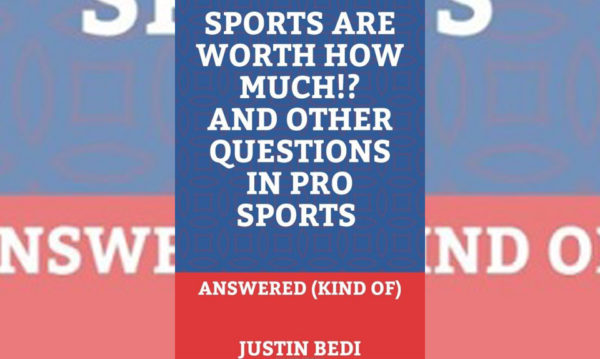UVic alumnus’s book a great insight into the economics of pro sports

UVic alumnus Justin Bedi’s book, “Sports are Worth How Much?! And Other Questions in Pro Sports.” Photo provided
Have you ever wondered why Golden State Warriors star Stephen Curry can earn a contract worth $201 million? Have you ever scratched your head when asked why tickets, jerseys and merchandise are so expensive, yet stadiums often become the burden of taxpayers? Are you confused as to why Duke University’s basketball program made $31 million in 2017, while the Blue Devils players themselves made nothing?
All these questions are answered in the semi-journalistic, fact-filled book Sports are Worth How Much!? And Other Questions in Pro Sports, by Canadian sports writer and UVic alumnus Justin Bedi. In the 191 pages, Bedi covers everything, from contracts to fantasy sports to video games, and the future of sports journalism. There are a lot of numbers in the book, but Bedi’s conversational writing style and breaking of the fourth wall makes them digestible.
Bedi also features charts and graphs, but they are used as visual aids for what he’s explaining, instead of as hard information. Although Bedi writes a lot about basketball and the NBA, he makes room for other sports, throwing in names like Sidney Crosby and Peyton Manning. There is even a whole chapter about hockey, which showcases Bedi’s funnier side, as well as his Canadian roots. The chapter on expansion teams was also amusing and surprisingly thought-provoking.
Bedi’s conversational style is perfect for the reader who gets a headache when reading dollar values, but there were some minor omissions I noticed when reading.
When Bedi talks about the 2011 film Moneyball, he fails to acknowledge Michael Lewis, the baseball analytics genius and author of the book that inspired it. There was no mention of Theo Epstein, who using Lewis’s method won two World Series, plus the magical 20-game win streak in Oakland. I suspect he did this on purpose to make it easier for non-sports fans to grasp, but if the reader is aware of of these names, their omission is obvious.
Another thing I noticed was the failure to mention the 1994–95 MLB strike which cancelled the season after August. I would have liked to see how strikes like this one (and the 2004–2005 NHL lockout) affected owners and fans; as Bedi proves, sports are worth a lot of money, and not selling tickets or signing contracts must leave a dent somewhere. There was also no discussion of agents, who play an important role when it comes to the worth of a player.
I would recommend Bedi’s book to someone who is interested in sports, their economics, and the social footprint they have, but be warned: this is very much a “sports” book. If you’ve never heard of names like Tom Brady, Peyton Manning, LeBron James, or Conor McGregor, it would be best to brush up before picking this up.
Also, if you’re looking for Bedi to have a strong opinion on an issue, you’re not going to find it. He often shows both the pros and cons of the subject, which can be frustrating because in doing so, he often skims the surface. (An example of this is the ‘should college players be paid?’ debate: he only touches upon some Division I sport and schools without examining the larger picture.)
Also, don’t expect a thought-provoking argument; Bedi is more analytical than he is positional. If you’re a seasoned sports fan who knows why Ken King is frustrated at Calgary’s mayor, why the Expos can’t have 1994 back, and what a “supermax” contract is, this book might seem like common knowledge, without much new to learn.
Officially, my verdict is this: Bedi’s book is incredibly good at taking hard-to-understand statistics and number values and talking about them as though you’re chatting with him at the bar. It is a quick read that will entertain on the bus or in bed. However, there may be too much raw information for those who have never watched sports; conversely, for those who have watched them all their lives, there might be too little.
Overall, if you are a curious sports fan who’s wondering where all the money’s going, Justin Bedi’s book is right for you.








